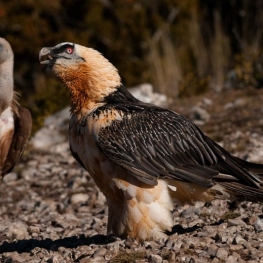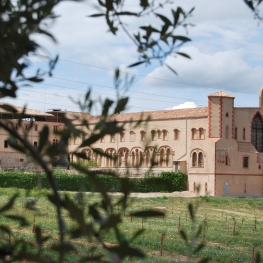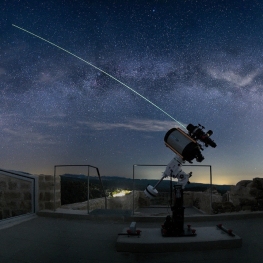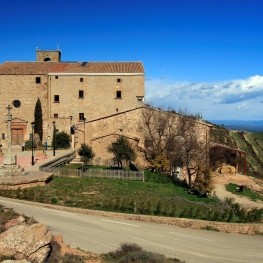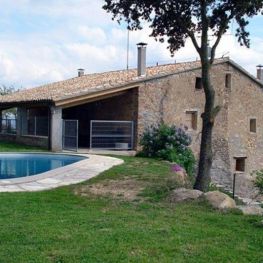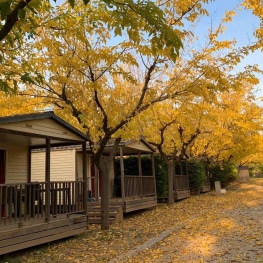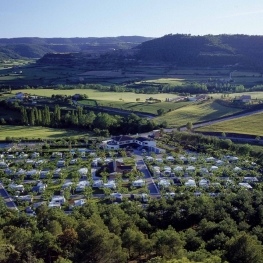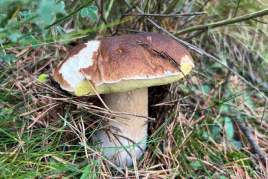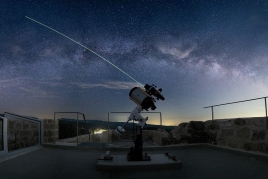Culture and adventure in the Rialb Reservoir
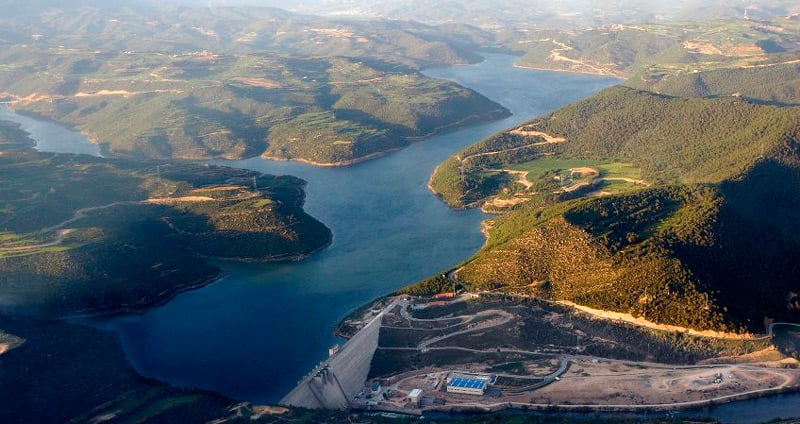
The Rialb reservoir, located in the regions of La Noguera and Alt Urgell, has become an ideal place for tourism, as it allows to combine contact with nature and cultural visits.
Practice adventure sports, discover the secrets of Romanesque churches and castles, know the history of the resurgence of a town that was drowned under the waters of the marsh, make the way to the sources of Oliana and Peramola or dare to approach one of the museums Most curious in Catalonia.
 The Rialb reservoir extends through the municipalities of Ponts, La Baronia de Rialb and Tiurana, of the region of La Noguera, and Bassella, Peramola and Oliana, to Alt Urgell. Inaugurated in 2000 and with a dam of 99m in height, the marsh collects the waters of the rivers Segre, Rialb and Riera Salada. It is managed by the Hydrographic Confederation of the Ebro and has the objective of providing supplies to the Urgell and Segarra-Garrigues Canals, which supply 80 population centers (200,000 inhabitants), and to retain a possible flood of the Segre. It also has a hydroelectric plant managed by NECSO SA with an estimated power of 100Gw per year.
The Rialb reservoir extends through the municipalities of Ponts, La Baronia de Rialb and Tiurana, of the region of La Noguera, and Bassella, Peramola and Oliana, to Alt Urgell. Inaugurated in 2000 and with a dam of 99m in height, the marsh collects the waters of the rivers Segre, Rialb and Riera Salada. It is managed by the Hydrographic Confederation of the Ebro and has the objective of providing supplies to the Urgell and Segarra-Garrigues Canals, which supply 80 population centers (200,000 inhabitants), and to retain a possible flood of the Segre. It also has a hydroelectric plant managed by NECSO SA with an estimated power of 100Gw per year.
The construction of the swamp began in 1992, a few kilometers from the swamp of Oliana and involved an investment of 240 million euros.
With a capacity of 402.8 hm3, the Rialb reservoir becomes the second largest in Catalonia, and has become a tourist attraction thanks to its environment of pure nature.
Thirty years of struggle
 The project for the construction of the Rialb reservoir dates back to the 1960s, but was delayed for various reasons. The main impediments to carrying out the project were the high cost of its construction and the opposition of the inhabitants of the municipalities of Miralpeix, Tiurana, Castellnou de Basella, Clua de Aguilar and Aguilar de Basella, who were to be evicted from their homes, In addition to being the most fertile land of the area under the waters of the new swamp.
The project for the construction of the Rialb reservoir dates back to the 1960s, but was delayed for various reasons. The main impediments to carrying out the project were the high cost of its construction and the opposition of the inhabitants of the municipalities of Miralpeix, Tiurana, Castellnou de Basella, Clua de Aguilar and Aguilar de Basella, who were to be evicted from their homes, In addition to being the most fertile land of the area under the waters of the new swamp.
In 1982, as a result of the serious damage caused by a flood of the Segre, the construction of the swamp was approved, but it was not until 1993 when the work began.
Two years later, in 1995, about 300 people had to be evicted in order to continue construction of the swamp, and it was in 1999 when the houses of the affected villages were demolished.
That same year a gradual process began to fill the reservoir and check the dam's resistance, but the lack of an emergency plan and continued droughts lengthened the process ten years more. Finally, in 2009 the swamp reached almost 80% of its capacity, becoming since then a swamp fully operative.
The resurgence of Tiurana
 In 1999 the inhabitants of Tiurana, one of the villages that had been demolished by the construction of the swamp of Rialb, created a new urban nucleus to about 3 km of the old town and within the same municipal term.
In 1999 the inhabitants of Tiurana, one of the villages that had been demolished by the construction of the swamp of Rialb, created a new urban nucleus to about 3 km of the old town and within the same municipal term.
Around the shrine of the Virgin of Solers, a sixteenth-century church dedicated to the patron saint of the village and decorated with baroque paintings, new houses were built and architectural elements of the old village were moved. They emphasize the cemetery, where you can visit a medieval sarcophagus of sandstone; The facade of the old parish of San Pedro de Tiurana, a gothic construction from 1545; A source of Arabic origin known as "El Pou" or the arcades of the main street.
 The German sculptor Christian Tobin designed a sculpture in the square of the new town, made up of three columns of about three meters that represent the three members of a family (father, mother and son), which move thanks to the force of water. The sculpture was inaugurated in September of 2006 and symbolizes the effort of a town that was drowned under waters that now give life to it through the movement of one of its new symbols.
The German sculptor Christian Tobin designed a sculpture in the square of the new town, made up of three columns of about three meters that represent the three members of a family (father, mother and son), which move thanks to the force of water. The sculpture was inaugurated in September of 2006 and symbolizes the effort of a town that was drowned under waters that now give life to it through the movement of one of its new symbols.
Nature in its purest form
 The geographical situation of the Rialb reservoir makes it possible to admire unspoiled landscapes with native vegetation made up mainly of red pines, oaks, oaks, juniper, poplars, willows and numerous medicinal plants such as horsetail, thyme or camomile.
The geographical situation of the Rialb reservoir makes it possible to admire unspoiled landscapes with native vegetation made up mainly of red pines, oaks, oaks, juniper, poplars, willows and numerous medicinal plants such as horsetail, thyme or camomile.
In the forests that surround the marsh live eagles, hares, foxes, wild boars and the bearded vulture, a bird typical of these humid landscapes.
In autumn, the mushroom seekers are in a suitable environment to enjoy their hobby, as they can find abundant níscalos, chanterelles, aguilares and negrillas.
Sports and adventure
 The architecture of the Rialb dam along with the many possibilities offered by its most unspoilt natural environment have made it an ideal place to practice all kinds of sports, from the quietest ones such as hiking and fishing, to adventure sports such as Rafting and canyoning.
The architecture of the Rialb dam along with the many possibilities offered by its most unspoilt natural environment have made it an ideal place to practice all kinds of sports, from the quietest ones such as hiking and fishing, to adventure sports such as Rafting and canyoning.
As for water sports, by offering specialized companies, canoeing, canoeing, kayaking, rafting down the Segre River and canyoning can be practiced in the swamp. Of this last activity they emphasize the Barranco del Boter, the highest waterfall of Catalonia with 1,000m of length and a difference of 500m, and Barranco de Gabarra, the longest descent of Catalonia, with a duration of between five and seven hours.
 In addition to sports, the marsh also offers a mooring service and rental of boats, kayaks and motorboats.
In addition to sports, the marsh also offers a mooring service and rental of boats, kayaks and motorboats.
 Very near the reservoir, in the town of Ogern and taking advantage of the water of the Ribera Salada, a mountain beach has been constructed that consists of two artificial ponds (one for adults and one for the small ones) and that it has service of bar And ample parking, perfect for a family day out.
Very near the reservoir, in the town of Ogern and taking advantage of the water of the Ribera Salada, a mountain beach has been constructed that consists of two artificial ponds (one for adults and one for the small ones) and that it has service of bar And ample parking, perfect for a family day out.
In terms of outdoor activities, climbing in the Rock of the Moors or in the ferrata route Regina de Peramola, one of the longest ferrata routes in Catalonia, and Nordic Walking, a walk of resistance organized by the City Council of Tiurana the last Sunday of each month.
You can also carry out aerial activities with ultralight, balloon or paragliding.
Discovering the sources of Peramola and Oliana
 Another activity that allows to admire the environment of the reservoir is the hiking. The most outstanding is a route north of the reservoir to discover the municipalities of Peramola and Oliana through their sources. In Peramola there is the bridge of the Fountain of the Village, the Fountain of the Mig, the Fountains of Christ and the People and the Fountain of the Caner, a place dedicated to the poet Miquel Martí i Pol. In Oliana a path surrounded by nature unites the Source of the Roqueta, the Source of Gotzens, the Source of the Agostants and the Source of the Metó.
Another activity that allows to admire the environment of the reservoir is the hiking. The most outstanding is a route north of the reservoir to discover the municipalities of Peramola and Oliana through their sources. In Peramola there is the bridge of the Fountain of the Village, the Fountain of the Mig, the Fountains of Christ and the People and the Fountain of the Caner, a place dedicated to the poet Miquel Martí i Pol. In Oliana a path surrounded by nature unites the Source of the Roqueta, the Source of Gotzens, the Source of the Agostants and the Source of the Metó.
A reservoir surrounded by history
Another way to enjoy the surroundings of the Rialb reservoir is to enjoy a cultural visit, whether visiting historic buildings such as churches and castles, or approaching one of the museums that surround you.
 Among the more than twenty buildings of Romanesque style that are preserved from the 11th century, stand out the hermitage of Santa Eulalia de Pomanyons de la Torra, which had to be moved following the construction of the Rialb reservoir; The church of San Martín de Terrassola, which was the religious center of the upper Rialb valley during the Middle Ages; San Salvador del Corb, the smallest Romanesque church in Catalonia and the church of Sant Ermengol, which is part of the path of religious heritage "Camino de Ermengol".
Among the more than twenty buildings of Romanesque style that are preserved from the 11th century, stand out the hermitage of Santa Eulalia de Pomanyons de la Torra, which had to be moved following the construction of the Rialb reservoir; The church of San Martín de Terrassola, which was the religious center of the upper Rialb valley during the Middle Ages; San Salvador del Corb, the smallest Romanesque church in Catalonia and the church of Sant Ermengol, which is part of the path of religious heritage "Camino de Ermengol".
 In addition to hermitages and churches, you can also visit ruins of Romanesque castles in Ponts ( Ponts Castle Ruins ), Peramola (Ruins of the Castle of Peramola) and Bassella (Ruins of the old Castle of Aguilar, popularly known as "La Torre de The Moors ").
In addition to hermitages and churches, you can also visit ruins of Romanesque castles in Ponts ( Ponts Castle Ruins ), Peramola (Ruins of the Castle of Peramola) and Bassella (Ruins of the old Castle of Aguilar, popularly known as "La Torre de The Moors ").
As for the museums, you can visit the Museum of the Ancient Offices of Tiurana; The Motorcycle Museum in Bassella, which includes the great collection of historical motorcycles; The Francisco Boncompte Museum, in Ponts, of which stands out the great collection of white arms and fire of all time; And the Oliana and Ponts ice wells.
What to do
Espai Natura Muntanya d’Alinyà
Fígols i Alinyà (a 14 Km)Refuge for emblematic species such as the chamois or the capercaillie, the…
Museu de les Trementinaires
Josa i Tuixent (a 27.6 Km)The Tuixent Trementinaires Museum opened its doors in 1998 to preserve the…
Mas de Colom, Casa Borges
Tàrrega (a 27.9 Km)The former convent and farmhouse are located on the Mas de Colom…
Centre Astronòmic del Castell de Lladurs
Lladurs (a 16.9 Km)The Lladurs Castle Astronomical Center will allow you to get closer to…
Where to eat
Taverna de La Vansa
La Vansa i Fórnols (a 22.7 Km)A self-managed mountain tavern in Espai La Vansa, ideal for enjoying local…
Bar Restaurant El Jardí
Sant Llorenç de Morunys (a 24 Km)The Bar-Restaurant El Jardí de Sant Llorenç de Morunys offers traditional cuisine…
Hostal de Pinós
Pinós (a 28.5 Km)It is the oldest restaurant in Catalonia that has never closed its…
Where to sleep
Mas Ampurdanés
La Baronia de Rialb (a 4.8 Km)It is located on the outskirts of Pallerols, in the municipality of…
Càmping Oliana
Oliana (a 1.2 Km)Enjoy an idyllic environment at Camping Oliana! Where you can stay in…
Alberg La Rectoria de la Selva, Fundesplai
Navès (a 27.5 Km)The Selva Rectory is located in the municipality of Navès. This colonial…
Càmping el Solsonès
Solsona (a 17.8 Km)Camping El Solsonès offers fully equipped wooden bungalows, a new camping area,…


